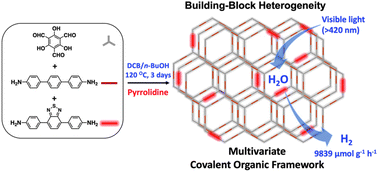Multivariate covalent organic frameworks boosting photocatalytic hydrogen evolution†
Abstract
Multivariate covalent organic frameworks (COFs) are a desirable platform for synergizing consecutive and multistep photocatalytic energy conversion via inherent functional modules. However, with a variation in the multicomponents in COFs, the ordering of a layered structure is impaired or even disappears, leading to notably weakened photocatalytic performance, as well as the incomplete understanding of the structure-to-performance relationships of multivariate COFs. Herein, we adopt an organobase-modulated multicomponent aldimine reaction to synthesize a series of β-ketoenamine-linked multivariate COFs consisting of 1,3,5-triformylphloroglucinol (Tp) as a fixed node and dual-component containing tertiary phenyl (TP) and benzothiadiazole-derived (BT) units as a tailored strut. The various Tp(BTxTP1−x)-COFs maintain high crystallinity and porosity and enable the sophisticated regulation of optical bandgaps and energy band positions by simply varying the feed amounts of the two amine species. More interestingly, the multivariate COFs facilitate exciton dissociation and free charge generation by virtue of the strong electron-deficient BT moiety as an acceptor. In visible photocatalytic water splitting measurements, the maximum hydrogen evolution rate is achieved by a multivariate COF containing 5 mol% of the BT component, reaching as high as 9839 μmol g−1 h−1, which is much higher than those of the parent COFs. With an increase in the BT moiety in the multicomponent skeletons, continuously declining performances are observed. It is likely that BT-induced excimer formation within the coaxial stacking layers may suppress the long-distance exciton diffusion towards the catalytic sites for the charge-carrier-triggered redox reaction. Our work opens up a promising route to modulate the photophysical properties of COFs via a facile bottom-up multicomponent design and sheds light on the structure-to-activity relationships of multivariate COFs in terms of their visible photocatalytic hydrogen evolution.



 Please wait while we load your content...
Please wait while we load your content...